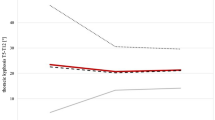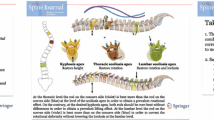Abstract
Since the definition of three-dimensional components of the scoliotic deformity, there have been important improvements in the surgical treatment of the problem. A derotation maneuver was proposed as a treatment option with CD instrumentation, but the reports of imbalance and decompensation with this system repopularized sublaminar wiring and translation as a corrective maneuver. Isola spinal instrumentation is one of the modern systems that utilizes vertebral translation instead of rod rotation. This study analyzes the results of 24 patients with idiopathic scoliosis who had been followed up for at least 2 years, and were surgically treated with titanium Isola Spinal Instrumentation in the Department of Orthopaedics and Traumatology, Ankara Social Security Hospital. Patients were grouped according to the King-Moe classification. Patients with type III, IV or V curves received only posterior instrumentation while this procedure followed anterior release and discectomy in the same session in patients with type I or II curves. A translation maneuver was utilized in the correction of scoliotic curves using the cantilever technique, either alone or supplemented by sublaminar wiring with Songer multifilament titanium cables. This study aimed to elucidate the effects of this technique in the frontal and sagittal plane curves and the trunk balance. The balance was analyzed clinically and radiologically by measurement of the lateral trunk shift (LT), shift of stable vertebra (SS), and shift of head (SH) in vertebral units (VU). The postoperative correction was significant in the frontal plane for all types of curves (p < 0.05). The postoperative correction was 80.9% ± 9.5% in type III curves. Overall, the mean Cobb angle of the major curve value in the frontal plane was 66.9°± 18.8°, and it was corrected by 62.8% ± 20.1%. The correction loss of Cobb angles in the frontal plane was 5.4°± 5.5° at the last follow-up visit. A normal physiologic thoracic contour (30°–50°) was achieved in 83.3% of the patients and normal lumbar contour (40°–60°) in 66.7% of the patients in the sagittal plane. The correction was found to be significant in all balance values (p < 0.05). The postoperative correction in LT values correlated with the correction of the Cobb angle values in the frontal plane. All patients had complete balance (SH: 0 VU and SS: 0 VU) or balanced curves (0 VU < SH, SS < 0.5 VU).Finally, the study concluded that the translation maneuver, especially when used with the cantilever technique, resulted in high correction rates in the frontal plane. Additionally, the technique was also successful in obtaining normal sagittal contours and correcting balance values.
Similar content being viewed by others
Author information
Authors and Affiliations
Additional information
Received: 26 April 1999
Rights and permissions
About this article
Cite this article
Benli, İ., Akalin, S., Aydin, E. et al. Isola spinal instrumentation system for idiopathic scoliosis. Arch Orth Traum Surg 121, 17–25 (2001). https://doi.org/10.1007/s004020000170
Issue Date:
DOI: https://doi.org/10.1007/s004020000170




